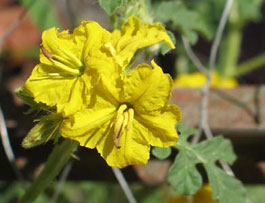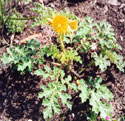Buffalobur
|
|
||
Solanum rostratum • Class C |
||
| Family Name: | Solanaceae (so-lan-AY-see-ee) | |
| Common: | The nightshade family | |
| Genus: |
Solanum (so-LAN-num) Meaning: Solace, quietude; referring to the narcotic properties of some species |
|
| Species: |
rostratum (ro-STRAY-tum) Meaning: With a beak |
|
| Description: |
Buffalobur is a fibrous rooted annual, with upright, heavy, branching stems. Plants grow up to 2 feet tall and are covered with straight yellow spines that are up to ½ inch long. Leaves are deeply lobed, alternate and prickly: leaves of older plants are up to 5 inches long. Its star shaped, yellow flowers bloom from midsummer till frost and are about one inch across and have 5 petals. The spiny fruit, or bur, develops while being enclosed by a rough, prickly calyx which surrounds the berry as it ripens. Seeds are black, flat and wrinkled. |
||||
| Why Is it a Noxious Plant? |
Buffalobur is the major native host plant of the Colorado potato beetle. It competes with forage and other crop plants for moisture. The plants can also accumulate toxic levels of nitrates from the soil. Hogs have been poisoned by eating Buffalobur foliage or roots. The burs become tangled in sheep wool, decreasing wool value.
|
||||
| Where Does it Grow? |
Buffalobur is found in meadows, dry rangeland, pastures, lawns, cultivated fields, roadsides and waste areas. Despite its imposing looks and toxic properties, it is not very competitive and survives only in disturbed, dry areas.
|
||||
| Facts: |
Its many sharp spines can cause intense, lingering pain if touched. Animals are also affected and even after the burs are removed, dogs will continue to lick and chew on their feet because of the pain.Its many sharp spines can cause intense, lingering pain if touched. Animals are also affected and even after the burs are removed, dogs will continue to lick and chew on their feet because of the pain.
|
||||
| Control Options: |
For small infestations digging, hoeing, or hand pulling before flowers appear is effective. Also mowing Buffalobur can prevent seed production. As an annual weed, management tactics that prevent flowering and seed set can be effective at controlling and eventually eradicating Buffalobur when the soil seed bank is exhausted. At the rosette stage 2, 4 D; Dicamba (used in Weedmaster) has been shown to be effective in controlling Buffalobur. When using herbicides, read and follow all label instructions and obey all label precautions. (Note: pesticide product registration is renewed annually and product names and formulations may vary from year to year.) |
||||
| More Information: |
Download our Flyer or visit Washington State Noxious Weed Control Board Here
|
||||
| More Pictures: |
|




